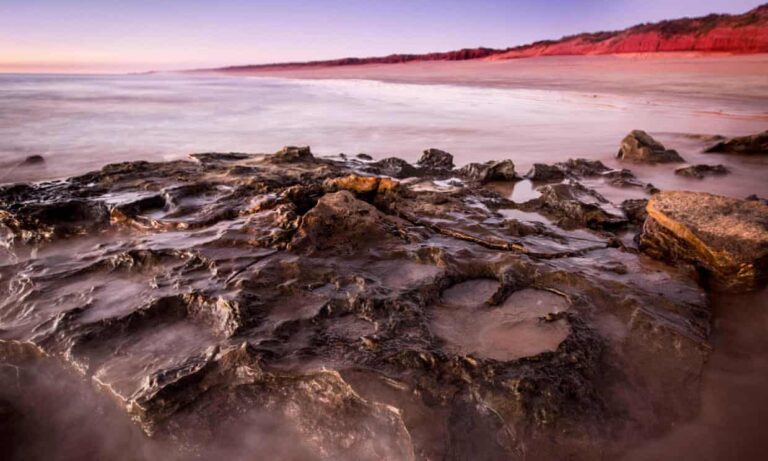Newly Discovered Human-Sized Dinosaur Footprint Is The Largest Ever Found
Scientists claim they have found “Australia’s Jurassic Park” along the rocky shores of Western Australia’s remote area of Kimberly. Palaeontologists have found a diverse collection of dinosaur footprints in the area, among them the largest dinosaur footprint known to science, as Jonathan Amos reports for the BBC.

The research team, consisting of palaeontologists from the University of Queensland and the University of James Cook, reported twenty-one types of fossil footprints stamped on the Dampier Peninsula sandstones.
Their findings were recently published in the Journal of Vertebrate Paleontology.
“There were five different types of predatory dinosaur tracks, at least six types of tracks from long-necked herbivorous sauropods, four types of tracks from two-legged herbivorous ornithopods, and six types of tracks from armoured dinosaurs,” lead researcher Steven Salisbury says in a statement.
The tracks also provide the only known evidence of stegosaurs in Australia, Salisbury notes.
One footprint spanned five feet and nine inches in length, making it the largest dinosaur track ever discovered, according to CNN’s Joshua Berlinger.
The print was left by a sauropod, a long-necked, four-legged herbivore
Dinosaurs plodded through the region some 130 million years ago, leaving their heavy tracks in the wet sands of a river delta. Speaking to Amos at the BBC, Salisbury said that the fossilized prints provide the “only window” into the presence of dinosaurs in Western Australia.
Relatively few traces of the prehistoric creatures have been found on the continent as a whole since Australia’s low-lying plains leave fossils susceptible to erosion by the elements.

Between 2011 and 2016, Salisbury and his team spent 400 hours examining and measuring the prints. They used photogrammetry to create models of the fossils, and took silicone casts of many of the prints, so they could be displayed in museums.
The tracks were usually only visible at low tide, and researchers “braved sharks, crocodiles, massive tides and the threat of development” as they worked in the area, according to the University of Queensland statement.
The prints had long gone unnoticed to palaeontologists, but indigenous lore has long attested to their existence. As Amos writes, the oral history of Australia’s indigenous people tells of a creator named Marala, or the Emu man, who left large, three-toed tracks as he walked across the land.
The Goolarabooloo people, a community of Aboriginal Australians, first alerted Salisbury to the presence of the footprints.
The Goolarabooloo are the “Traditional Custodians” of Walmadany, an area of the Dampier Peninsula where most of the prints are concentrated.
In 2008, the Australian government announced that it intended to build a gas processing plant in Walmadany. Goolarabooloo leaders hoped their land would be preserved if Salisbury could confirm that dinosaur fossils existed in the region.

“We needed the world to see what was at stake,” Goolarabooloo “Law Boss” Phillip Roe said, according to the University of Queensland Statement.
Plans for the Walmadany gas plant were halted when a gas company decided that it would not be economically feasible to proceed with the project. The area has also been granted National Heritage status, according Ben Collins of ABC Australia.
Curious spectators will be able to explore the remarkable collection of footprints. Salisbury told Collins that one of the best ways to view the tracks is by walking the Lurujarri Heritage Trail—a nine-day hike that follows paths laid out in indigenous oral history.